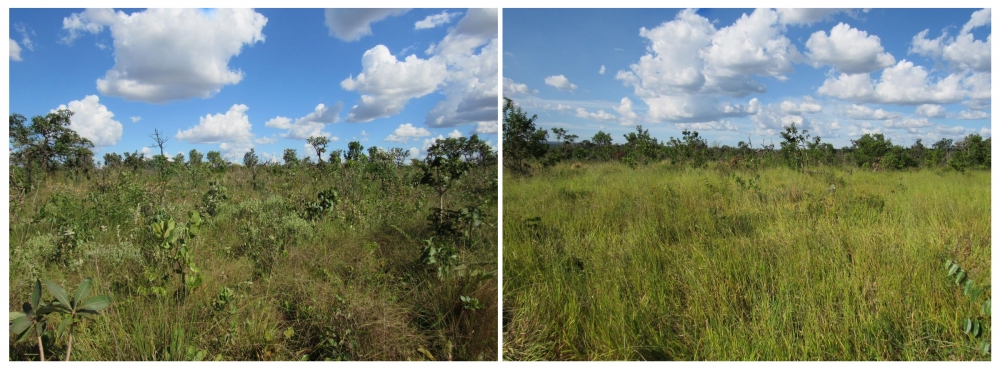

Researchers in Brazil, Argentina, Chile, and the UK are participating in the initiative. Results are published in the journal BioScience (photographs showing a non-invaded area [left] and an area invaded by Urochloa brizantha [palisade grass, right] / Gabriella Damasceno)
Researchers in Brazil, Argentina, Chile, and the UK are participating in the initiative. Results are published in the journal BioScience.
Researchers in Brazil, Argentina, Chile, and the UK are participating in the initiative. Results are published in the journal BioScience.

Researchers in Brazil, Argentina, Chile, and the UK are participating in the initiative. Results are published in the journal BioScience (photographs showing a non-invaded area [left] and an area invaded by Urochloa brizantha [palisade grass, right] / Gabriella Damasceno)
By José Tadeu Arantes | Agência FAPESP – Invasive alien species, defined as animals and plants that breed and disperse in a landscape beyond their native range, have negative environmental, social, and economic impacts. One example among many is the forage grass genus Brachiaria, originally African and introduced to Brazil to form cattle pasture. It has become a major threat to the survival of native species and biodiversity at several spatial scales.
Complete eradication of invasive species is often impracticable. Attempts to do so have had undesirable consequences and even been damaging because merely withdrawing an invasive species does not restore the original environment, as in the areas of Cerrado (Brazilian savanna) invaded by pines. Instead of eradication, therefore, the goal should be continuous management, according to many experts. This is the line taken by researchers from Brazil, Argentina, Chile, and the United Kingdom, who have agreed on a strategic approach focusing on impact mitigation rather than elimination.
They call their project CONTAIN Latam. The name refers to the impossibility of eradicating invasive non-native species and the need for containment of their growth and impacts.
The project resulted from a 2018 call for proposals issued under the aegis of a cooperation agreement involving FAPESP, the UK Natural Environment Research Council (NERC), UK Research and Innovation (UKRI), the Newton Fund, Argentina’s National Scientific and Technical Research Council (CONICET), Chile’s National Commission for Scientific and Technological Research (CONICYT), and Peru’s National Council for Science, Technology and Technological Innovation (CONCYTEC).
The initiative aims at developing management tools to optimize the control of invasive species in the medium to long term. The Brazilian members of the group are affiliated with São Paulo State University (UNESP) and coordinated by Alessandra Fidelis, a professor in UNESP’s Rio Claro Institute of Biosciences.
A study by the CONTAIN group is the subject of an article published recently in the journal BioScience. The study was supported by FAPESP via a research project for which Fidelis is principal investigator in Brazil.
“Our study set out not just to analyze invasive species but also to put forward guidelines for interaction with managers with the aim of containing proliferation of these species and mitigating their impacts,” Fidelis told Agência FAPESP.
The full definition stated early on in the article is that invasive species “successfully transition the three initial invasion stages (transport, introduction, and establishment) and subsequently establish multiple self-sustaining populations composed of individuals that breed, survive and disperse in a landscape beyond their native range”, and that a “subset” of invasive species produces an array of “negative environmental, social, and economic impacts at various spatial scales”.
In this vast subset, the project focuses on the following: in Brazil, Brachiaria spp., Urochloa spp. and other grasses of African origin introduced as forage crops for cattle pasture, and pines (Pinus spp.) introduced from the northern hemisphere for reforestation and to produce pulp and resin; in Argentina, American mink (Neovison vison) introduced for fur production, pines, and privet (Ligustrum spp.), of Asian origin and introduced here as a street tree, hedge or ornamental plant; in Chile, pines, mink, and the Yellowjacket or German wasp (Vespula germanica) whose origin is hitherto unknown.
“We propose six criteria for planning to mitigate their impacts. The first three comprise a detailed survey of the situation: mapping their presence and spatial distribution, finding out how long each invasive species has been present and compiling the available data on their impacts,” Fidelis said. “The next three relate to the recommended responses to the situation: the kinds of intervention that are technically, socially, and economically feasible, the potential negative consequences of these interventions, and a cost-benefit analysis of the interventions and their consequences.”
The COVID-19 pandemic has shone a bright light on the risks of degrading the natural environment and the urgent need to implement science-based policies for controlling and mitigating these risks. “In the case of the species on which our study focused, there’s a very strong additional reason for implementing such policies, as mink have been found to be transmitters of the novel coronavirus,” Fidelis said.
All this will evidently be ineffectual unless the knowledge produced by universities and research institutions can cross over from academia to society in general, and especially to those responsible for managing public and private affairs.
The article “Management policies for invasive alien species: addressing the impacts rather than the species” can be retrieved from: doi.org/10.1093/biosci/biaa139.
2
Republish
The Agency FAPESP licenses news via Creative Commons (CC-BY-NC-ND) so that they can be republished free of charge and in a simple way by other digital or printed vehicles. Agência FAPESP must be credited as the source of the content being republished and the name of the reporter (if any) must be attributed. Using the HMTL button below allows compliance with these rules, detailed in Digital Republishing Policy FAPESP.





